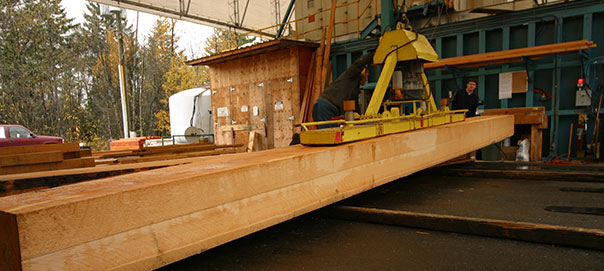
Why Dry Timbers?
Industry wide, most timber frame construction is done with either green or air-dried timbers. The difficulty in building with green or air-dried timbers is that the wood is more unstable than we would like. Tight joints created by craftsman during construction later can become huge gaps. Checking, not present upon installation of large trusses, can become pronounced cracks six months down the road. The reality and difficulty in building with beautiful wood is that as it dries, it shrinks.
More than 50% of the weight associated with freshly cut “green” softwood is water content (referred to as moisture content). Conventional kilns that utilize de-humidification or high temperatures to dry timbers present limitations due to the fact that the wood dries from the “outside in” generally only drying the outer layer of the timbers. As a result, the inner core of the timbers retain a high level of moisture content, often causing them to cup, check, and warp as they continue to dry out over time.
Such limitations associated with conventional kiln drying can negatively affect the aesthetic and structural integrity of the end product. This occurrence is magnified when drying large-sized timbers with large surfaces. Not only is it time consuming and therefore expensive to let large timbers air-dry, but the end result is unpredictable. Even conventional kiln operators are reluctant to dry large timbers because of the length of time it takes to reach a specific moisture content as well as the inconsistency associated with the end product.
RFV Kiln technology removes the unpredictability associated with drying large-sized timbers based on the fact that this technology dries the entire timber evenly down to its core. Large appearance grade timbers can now be dried economically and uniformly in a matter of days while maintaining the structural integrity of the timber. Arc’s timbers will arrive to you in a state that they will remain, giving the builder much more control of the finished product.
Arc’s old growth timbers, combined with RFV kiln technology, produce some of the most beautiful, stable and structurally sound timber products worldwide.
The RFV Kiln Process
At Arc Wood & Timbers, we utilize cutting edge technology to dry our timbers from the “inside out” in a state of the art Radio Frequency Vacuum Kiln (RFV Kiln). This advanced process of drying timbers is the most precise, stable, and efficient method available in the timber industry today. In Japan, where precise joinery is an integral part of its construction heritage, RFV Kiln drying is a key factor in achieving the renowned quality of the design and construction of Japanese tea houses and temples.
The accuracy and consistency of this timber drying method is one of the key elements that differentiate Arc’s quality timber products from other suppliers. The drying process utilizes radio frequency electromagnetic waves, low temperatures, a vacuum environment and extreme pressure loads to dry timbers 20 times faster than conventional drying methods. For example, Arc can RFV Kiln dry a 12″ x 12″ x 40′ timber down to a uniform 12% moisture content in just 4-5 days compared to 3 – 4 months when using conventional drying methods. This increased efficiency is extremely important when ordering structural timbers that must adhere to strict lead times.
At Arc, we understand that meeting building schedule is critical to our customers; the RFV Kiln gives us a competitive advantage to deliver a high quality product on time.
RFV Kiln dried timbers are a craftsman dream. With this new drying technology, the precise workmanship of a craftsman is no longer subject to the gross movements of conventionally dried or green timbers. The benefits of the lumber’s stability are not only aesthetic, but also structural. Joints that are tight upon initial construction will remain that way.
The benefits of minimal movement, checking, twisting or splitting will be noticed and appreciated on your project for as long as the structure stands.
